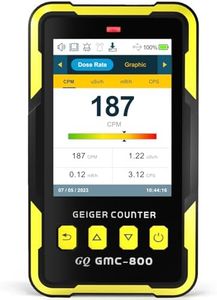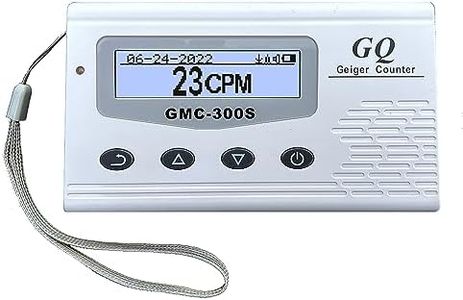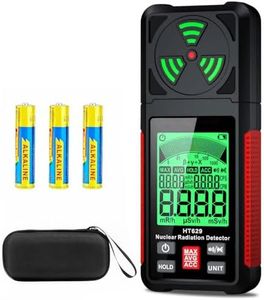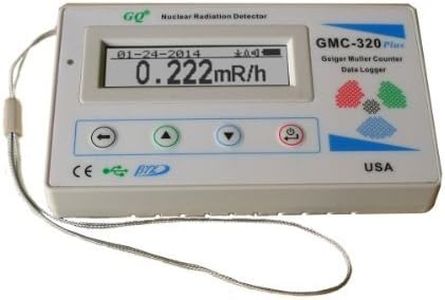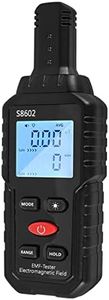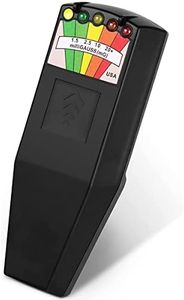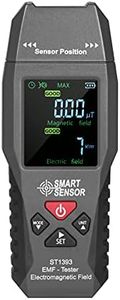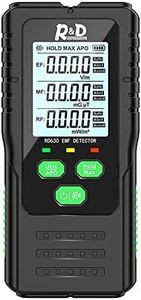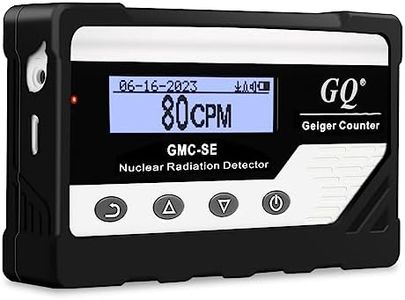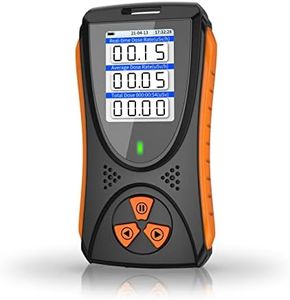We Use CookiesWe use cookies to enhance the security, performance,
functionality and for analytical and promotional activities. By continuing to browse this site you
are agreeing to our privacy policy
10 Best Handheld Radiation Detectors
From leading brands and best sellers available on the web.Buying Guide for the Best Handheld Radiation Detectors
When choosing a handheld radiation detector, it's important to focus on how you'll use the device and what types of radiation you need to detect. Think about the environments you'll use it in—are you a hobbyist, a professional in safety, or someone needing readings in specific areas such as medical, industrial, or environmental? Good detectors balance ease of use with measurement accuracy and reliability. You want a device that's comfortable to use, gives clear feedback, and covers the types of radiation you're concerned about. Paying attention to key specifications will help you pick the right tool for your needs.Radiation Types DetectedThis specification tells you what kind of radiation the detector can sense—usually alpha, beta, gamma, or x-ray. Each type has different properties, with alpha being easy to block and gamma being the most penetrating. It’s important because not all detectors sense every type. Some are focused only on gamma and x-rays (common for general safety), while others pick up alpha and beta for more specialized checks. If you only need to check for general radiation exposure, gamma and x-ray detection may be sufficient. For work involving radioactive materials or contamination, having alpha and beta detection becomes necessary.
Sensitivity and RangeSensitivity refers to how small a level of radiation the device can detect, while range is about the highest and lowest levels it can accurately measure. This matters because higher sensitivity is crucial when you're detecting low-level contamination, but not as important for general safety checks. Ranges are often divided into low (background radiation), medium (medical or industrial settings), and high (emergencies or incidents). Select a range that matches your usual environment: low-range for environmental monitoring, medium for medical/industrial, and high for emergency response.
Measurement Units and DisplayMost detectors show results in units like microsievert per hour (µSv/h) or millirem per hour (mR/h). This spec is important because clear, understandable readouts prevent confusion, especially in urgent situations. Better devices let you choose or switch between units. If you're new to radiation detection, make sure the model provides simple numeric readings or audible/visual alerts to easily recognize unsafe levels.
Detector Type (Sensor Technology)The type of sensor—like Geiger-Müller tube, scintillation, or semiconductor—affects accuracy, sensitivity, and speed. Geiger-Müller tubes are common and affordable, good for general use. Scintillation sensors are better for precise, low-level detection but may be more complex. Semiconductors are quick and often more durable. For everyday monitoring, Geiger-Müller is usually enough, but if precision or low-level detection is important, look for scintillation or semiconductor technology.
Size and PortabilityThis covers both the physical size and the weight of the device, affecting how easy it is to carry around or handle for longer periods. Smaller, lightweight models are great for quick field checks or for carrying all day, while larger models may be fine if you’re stationary. Go for compact and ergonomic models if you plan to use it often on the move.
Battery Life and Power OptionsHandheld radiation detectors are battery powered, and this spec tells you how long the device will work before you need to recharge or replace batteries. It’s crucial for field work or emergencies where you can't recharge easily. Battery life can be short (a few hours), medium (a day), or long (several days). Pick long battery life for field use, while short is often okay for quick spot-checks at home or in facilities with easy access to power.
Data Logging and ConnectivitySome detectors can record measurements over time and transfer this data to a computer or phone. This is important for advanced users needing to track exposure or analyze trends, such as professionals or researchers. Features range from no data logging, simple storage, to app/PC connectivity via USB or Bluetooth. If you need to keep records, look for models with built-in data logging or wireless connectivity.
Alarm and Alert FunctionsAlarms alert you when radiation exceeds a set level, which is key for safety. Simple models may beep or flash, while more advanced ones offer customizable thresholds, vibrations, or voice alerts. Having alarms is essential if you use the device in situations where you may be exposed to dangerous levels of radiation unexpectedly.

